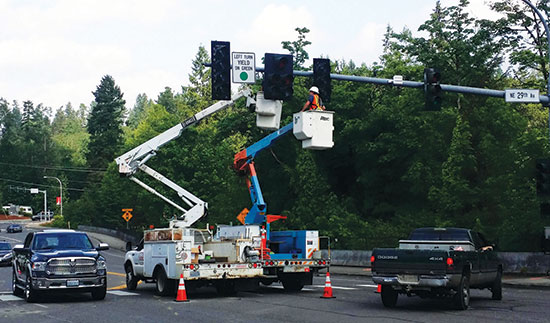Automated Traffic Signal Performance Measures Case Studies:
Clark County, Washington
Printable Version [PDF, 1.2MB]
You may need the Adobe® Reader® to view the PDFs
on this page.
Contact Information: Operations Feedback at OperationsFeedback@dot.gov

U.S. Department of Transportation
Federal Highway Administration
Office of Operations
1200 New Jersey Avenue, SE
Washington, DC 20590
FHWA-HOP-18-049
December 2018
Clark County, WA Traffic Signal Program Overview

Traffic Signal Systems Capability Maturity Self Assessment

Traffic Signal Systems Capability Maturity Self-Evaluation Tool: https://ops.fhwa.dot.gov/tsmoframeworktool/tool/tssc/
ATSPM Capability
Clark County, Washington, has implemented Automated Traffic Signal Performance Measures (ATSPM) as part of the overarching Signal Timing, Evaluation, Verification, and Enhancement (STEVE) program. Clark County's ATSPM system objectives are:
- Time the signals for safe and efficient travel.
- Manage the existing roadways.
- Defer expensive capital projects.
- Gather data to help make decisions.
- Provide information to the public.
Clark County's system is the outcome of a collaborative effort with Trafficware to develop an ATSPM module that stores and supports the evaluation of High-Resolution Data, Bluetooth data, alarms and event logs, and other signal timing events to develop performance measures that are consistent with the traffic signal program's objectives. ATSPM data are manually analyzed by staff to assess performance. To reduce staff time spent analyzing data and improve the depth and breadth of traffic signal performance, Clark County is developing an ATSPM dashboard. The dashboard will provide near real-time transportation network performance information. The dashboard will help traffic engineers analyze data to determine how the transportation system is operating compared with recent traffic trends and performance metrics associated with individual corridors. The system will automatically flag current operations that are outside accepted performance parameters. These checks are also monitored to determine if an occurrence is a one-time instance or an ongoing situation.
ATSPM System Maturity

Photo credit: Clark County
"So why are we doing ATSPMs? You can't improve if you don't measure."
Traffic Signals Manager
The first phase of ATSPM implementation started in 2014, with a pilot project where the Southwest Washington Regional Transportation Council worked with Clark County, the City of Vancouver, and Washington State Department of Transportation (WSDOT). This first phase encompassed the central ATSPM system software updating traffic signal controller software and firmware along major arterials. The second phase of the pilot project included equipping signals along major arterial streets with Bluetooth sensors to enable additional detection capabilities. The system provides near real-time data that is used to review the county's central traffic responsive and adaptive signals operation based on the performance of the intersection over the previous 15 minutes. With Bluetooth detection, the overall travel time of the corridor and the percentage of vehicles arriving on green can be measured. The overall travel time and the percentage of vehicles arriving on green can be used to further improve operations.
Clark County has upgraded 100 percent of its 106 traffic signals to be ATSPM capable. With upgraded controllers, the timing of these signals can be adjusted in real time based on data automatically collected. Additional Bluetooth data collection devices continue to be installed along major corridors to provide additional data to improve the operation of the system.
Budget
Phase 1 of STEVE involved upgrading signal software and firmware to be ATSPM capable. The total cost of Phase 1 was $950,000 of which $760,000 was from a federal grant. Local funds covered the remainder of the cost. Phase 2 Bluetooth installation was approximately $460,000, of which $342,000 was granted from federal sources. The dashboard component of Clark County's ATSPM is expected to cost $600,000.
ATSPM IMPLEMENTATION
Clark County's ATSPM implementation benefited from proactive partnership and collaboration with Southwest Washington Regional Transportation Council, the City of Vancouver, and WSDOT. Volume and speed data collected at ATSPM capable signals in Clark County are shared with the public through an online database, PORTAL, run by Portland State University. New data analysis and reporting frameworks for ATSPM data will be developed in phase 2 of the project.

Photo credit: Clark County
ADDITIONAL RESOURCES
- To learn more, visit https://www.clark.wa.gov/public-works/traffic-signals and https://ops.fhwa.dot.gov/arterial_mgmt/performance_measures.htm
- More information on Automated Traffic Signal Performance Measures is available on the Every Day Counts website at https://www.fhwa.dot.gov/innovation/everydaycounts/edc_4/atspm.cfm
For additional information please contact:
Eddie Curtis, FHWA Resource Center, 404-562-3920, Eddie.Curtis@dot.gov

Every Day Counts (EDC), a State-based initiative of FHWA's Center for Accelerating Innovation, works with State, local, and private sector partners to encourage the adoption of proven technologies and innovations aimed at shortening and enhancing project delivery.
www.fhwa.dot.gov/innovation/everydaycounts/